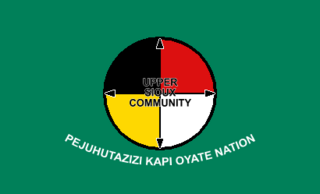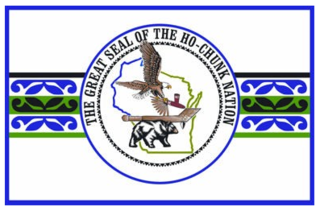
The Sauk or Sac are a group of Native Americans of the Eastern Woodlands culture group, who lived primarily in the region of what is now Green Bay, Wisconsin, when first encountered by the French in 1667. Their autonym is oθaakiiwaki, and their exonym is Ozaagii(-wag) in Ojibwe. The latter name was transliterated into French and English by colonists of those cultures. Today they have three federally recognized tribes, together with the Meskwaki (Fox), located in Iowa, Oklahoma and Kansas.

Tama County is a county located in the U.S. state of Iowa. As of the 2020 census, the population was 17,135. Its county seat is Toledo. The county was formed on February 17, 1843 and named for Taimah, a leader of the Meskwaki people.

Tama is a city in Tama County, Iowa, United States. The population was 3,130 at the time of the 2020 census.

Prairie Island Indian Community is a Mdewakanton Sioux Indian reservation in Goodhue County, Minnesota, along the Mississippi River. Most of the reservation now lies within the city of Red Wing, which developed after this land was set aside.

The Sac and Fox Nation is the largest of three federally recognized tribes of Sauk and Meskwaki (Fox) Indian peoples. Originally from the Lake Huron and Lake Michigan area, they were forcibly relocated to Oklahoma in the 1870s and are predominantly Sauk. The Sac and Fox Oklahoma Tribal Statistical Area (OTSA) is the land base in Oklahoma governed by the tribe.

The L'Anse Indian Reservation is the land base of the federally recognized Keweenaw Bay Indian Community of the historic Lake Superior Band of Chippewa Indians.. The reservation is located primarily in two non-contiguous sections on either side of the Keweenaw Bay in Baraga County in the Upper Peninsula of the U.S. state of Michigan. The Keweenaw Bay Community also manages the separate Ontonagon Indian Reservation.

The Leech Lake Reservation is an Indian reservation located in the north-central Minnesota counties of Cass, Itasca, Beltrami, and Hubbard. The reservation forms the land base for the federally recognized Leech Lake Band of Ojibwe, one of six bands comprising the Minnesota Chippewa Tribe, organized in 1934. The Leech Lake Reservation has the second highest population of any reservation in Minnesota with White Earth Nation being the largest Minnesota Ojibwe tribe, Leech Lake Nation has a resident population of 11,388 indicated by the 2020 census.
Mille Lacs Indian Reservation is the popular name for the land-base for the Mille Lacs Band of Ojibwe in Central Minnesota, about 100 miles (160 km) north of Minneapolis-St. Paul. The contemporary Mille Lacs Band reservation has significant land holdings in Mille Lacs, Pine, Aitkin and Crow Wing counties, as well as other land holdings in Kanabec, Morrison, and Otter Tail Counties. Mille Lacs Indian Reservation is also the name of a formal Indian reservation established in 1855. It is one of the two formal reservations on which the contemporary Mille Lacs Band retains land holdings. The contemporary Mille Lacs band includes several aboriginal Ojibwe bands and villages, whose members reside in communities throughout central Minnesota.

The Upper Sioux Indian Reservation, or Pezihutazizi in Dakota, is the reservation of the Upper Sioux Community, a federally recognized tribe of the Dakota people, that includes the Mdewakanton.

The Iowa Tribe of Kansas and Nebraska is one of two federally recognized tribes of Iowa people. The other is the Iowa Tribe of Oklahoma.

The Meskwaki, also known by the European exonyms Fox Indians or the Fox, are a Native American people. They have been closely linked to the Sauk people of the same language family. In the Meskwaki language, the Meskwaki call themselves Meshkwahkihaki, which means "the Red-Earths", related to their creation story.

The Hannahville Indian Community is a federally recognized Potawatomi tribe residing in Michigan's Upper Peninsula, approximately 15 miles (24 km) west of Escanaba on a 8.5755-square-mile (22.210 km2) reservation. The reservation, at 45°46′59″N87°25′23″W, lies mostly in Harris Township in eastern Menominee County, but a small part is located in northeastern Gourley Township, also in Menominee County, and another in Bark River Township in adjacent southwestern Delta County.

The Menominee Indian Reservation is an Indian reservation located in northeastern Wisconsin held in trust by the United States for the Menominee Tribe of Wisconsin. It is the largest Indian reservation east of the Mississippi River. In the Menominee language, it is called Omāēqnomenēw-Otāēskonenan, "Menominee Thing Set Apart", or alternatively omǣqnomenēw-ahkīheh, "in the Menominee Country".

The Ho-Chunk Nation is a federally recognized tribe of the Ho-Chunk with traditional territory across five states in the United States: Wisconsin, Illinois, Iowa, Minnesota, and Missouri. The other federally recognized tribe of Ho-Chunk people is the Winnebago Tribe of Nebraska. The tribe separated when its members were forcibly relocated first to an eastern part of Iowa known as the Neutral Ground, then to Minnesota, South Dakota and later to the current reservation in Nebraska.

The Winnebago Reservation of the Winnebago Tribe of Nebraska is located in Thurston County, Nebraska, United States. The tribal council offices are located in the town of Winnebago. The villages of Emerson, south of First Street, as well as Thurston, are also located on the reservation. The reservation occupies northern Thurston County, Nebraska, as well as southeastern Dixon County and Woodbury County, Iowa, and a small plot of off-reservation land of southern Craig Township in Burt County, Nebraska. The other federally recognized Winnebago tribe is the Ho-Chunk Nation of Wisconsin.
The Sac and Fox Reservation of Sauk (Sac) and Meskwaki (Fox) people is a 23.639 sq mi (61.226 km²) tract located in southeastern Richardson County, Nebraska, and northeastern Brown County, Kansas. It governed by the Sac and Fox Nation of Missouri in Kansas and Nebraska, and the headquarters for reservation is in Reserve, Kansas. The tribal jurisdiction area is west of White Cloud, Kansas and northeast of Hiawatha, Kansas. It was created as a consequence of the Platte Purchase of 1836.

The Sac and Fox Nation of Missouri in Kansas and Nebraska is one of three federally recognized Native American tribes of Sac and Meskwaki (Fox) peoples. Their name for themselves is Nemahahaki and they are an Algonquian people and Eastern Woodland culture.

The Sac and Fox Tribe of the Mississippi in Iowa is one of three federally recognized Native American tribes of Sac and Meskwaki (Fox) peoples in the United States. The Fox call themselves Meskwaki and because they are the dominant people in this tribe, it is also simply called Meskwaki Nation, the Sauk people call themselves Êshkwîha or Yochikwîka, both with the meaning "Northern Sauk". They are Algonquian peoples, historically developed in the Eastern Woodland culture. The settlement, called Meskwakiinaki, is located in Tama County, Iowa.
Meskwaki Settlement School (MSS) is a tribally controlled school with oversight by the Bureau of Indian Education, is located in the Meskwaki Nation, also known as the Meskwaki Settlement. It is in unincorporated Tama County, Iowa, about 4 miles (6.4 km) west of Tama, and is a property of the Sac and Fox Tribe of the Mississippi in Iowa.
Jean Adeline Morgan Wanatee was a Meskwaki activist for Native American and women's rights. Wanatee was an artist and tribal leader dedicated to preserving and sharing the traditional culture and language of the Meskwaki. She was the first woman elected to the Meskwaki Tribal Council and the first Native American to be inducted into the Iowa Women's Hall of Fame.



















